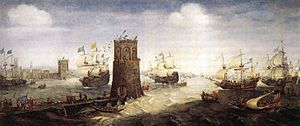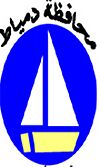Damietta facts for kids
Quick facts for kids
Damietta
|
|||
|---|---|---|---|
|
(From top left)
the Old Bridge, Maeini Mosque entrance, Damietta Corniche, Maeini Mosque dome, fishing in Damietta. |
|||
|
|||
| Country | |||
| Governorate | Damietta | ||
| Area | |||
| • City | 3.53 km2 (1.36 sq mi) | ||
| Elevation | 16 m (52 ft) | ||
| Population
(2024)
|
|||
| • City | 305,920 | ||
| • Density | 1,734,262/km2 (4,491,720/sq mi) | ||
| • Metro | 1,100,000 | ||
| Demonym(s) | Damiettan | ||
| GDP | |||
| • Metro | EGP 110 billion (US$ 7 billion) |
||
| Time zone | UTC+2 (EST) | ||
| Area code(s) | (+20) 57 | ||


Damietta (Arabic: دمياط Dumyāṭ; Coptic: ⲧⲁⲙⲓⲁϯ, romanized: Tamiati) is a busy port city in Egypt. It is the capital of the Damietta Governorate. The city is located on the eastern branch of the Nile River, which flows into the Mediterranean Sea. It is about 15 kilometers (9.3 miles) from the sea and 200 kilometers (124 miles) north of Cairo, Egypt's capital. Damietta is also part of the UNESCO Global Network of Learning Cities, which means it helps its citizens keep learning throughout their lives.
Contents
What's in a Name?
The name "Damietta" comes from its older Coptic name, Tamiati. This name probably came from an ancient Egyptian word, "dmj," which means "mooring," "port," or "town." So, the name has always been linked to its role as a port city.
A Look Back: Damietta's History
Damietta has a long and exciting history, especially because of its important location near the Nile and the sea.
Early Days and Arab Rule
The city was known as Tamíathis in ancient Greek times. In the 7th century, the Arabs took control of the city. They successfully defended it many times from attacks by the Byzantine Empire, which was a powerful empire at the time. Damietta became an important naval base and a key port for trade with places like India and China.
The Crusades and Damietta
Damietta played a big role during the Crusades in the 12th and 13th centuries. The Crusaders were European Christians who tried to take back control of the Holy Land.
The Fifth Crusade
In 1217, the Crusaders decided that capturing Damietta was very important. They believed that if they controlled Damietta, they would control the Nile River. From there, they thought they could conquer all of Egypt and then move on to take back Jerusalem.
After a long siege that lasted from 1218 to 1219, the Crusaders finally captured the city. This siege caused a lot of damage and suffering to the people of Damietta. However, their plan to march to Cairo failed, and they were defeated in 1221.
The Seventh Crusade
Damietta was attacked again in 1249 during the Seventh Crusade, led by Louis IX of France. His army quickly captured the fort. But Louis and his army were later captured in 1250. To gain their freedom, Louis had to give Damietta back.
Because Damietta was so important to the Crusaders, the Mamluk ruler Baybars decided to destroy the city in 1251. He then rebuilt it a few kilometers away from the Nile in the 1260s. He also made sure the mouth of the Nile branch was blocked so that enemy ships could not easily enter.
What's the Weather Like?
Damietta has a hot desert climate. However, winds blowing from the Mediterranean Sea make the temperatures much milder. This is typical for cities along Egypt's northern coast.
Summers in Damietta are moderately hot and humid. Winters are mild and can be quite wet, with some sleet and hail. Damietta has one of the smallest temperature changes in Egypt throughout the year.
| Climate data for Damietta, Egypt | |||||||||||||
|---|---|---|---|---|---|---|---|---|---|---|---|---|---|
| Month | Jan | Feb | Mar | Apr | May | Jun | Jul | Aug | Sep | Oct | Nov | Dec | Year |
| Mean daily maximum °C (°F) | 17.2 (63.0) |
18.1 (64.6) |
19.9 (67.8) |
23.2 (73.8) |
27.3 (81.1) |
28.8 (83.8) |
29.9 (85.8) |
30.3 (86.5) |
28.9 (84.0) |
27.3 (81.1) |
23.8 (74.8) |
19.2 (66.6) |
24.5 (76.1) |
| Daily mean °C (°F) | 13.2 (55.8) |
13.8 (56.8) |
15.4 (59.7) |
18.4 (65.1) |
22.2 (72.0) |
24.2 (75.6) |
25.9 (78.6) |
26.3 (79.3) |
24.8 (76.6) |
23.3 (73.9) |
19.8 (67.6) |
15.2 (59.4) |
20.2 (68.4) |
| Mean daily minimum °C (°F) | 9.2 (48.6) |
9.6 (49.3) |
11.0 (51.8) |
13.6 (56.5) |
17.1 (62.8) |
19.7 (67.5) |
22.0 (71.6) |
22.3 (72.1) |
20.7 (69.3) |
19.3 (66.7) |
15.8 (60.4) |
11.3 (52.3) |
16.0 (60.7) |
| Average precipitation mm (inches) | 26 (1.0) |
18 (0.7) |
13 (0.5) |
5 (0.2) |
2 (0.1) |
0 (0) |
0 (0) |
0 (0) |
0 (0) |
7 (0.3) |
15 (0.6) |
25 (1.0) |
111 (4.4) |
| Source: climate-data.org | |||||||||||||
Damietta's Economy
Damietta is famous for its furniture industry. Furniture made here is sold not only in Egypt but also in many other countries around the world.
The city is also an important port again, thanks to a canal connecting it to the Nile. A new port, Damietta Port, handles large shipping containers. The area also has a plant that turns natural gas into Liquefied Natural Gas (LNG). There's also a methanol plant and a woodworking industry.
Besides these, Damietta is known for its delicious White Domiati cheese and other dairy products. It also produces tasty pastries and Egyptian desserts. Fishing is another important activity in this port city.
Places to See in Damietta
Damietta has several interesting historical sites and landmarks:
Mosques
- Amr ibn al-As Mosque (Damietta): This is the second mosque ever built in Egypt and Africa by the Arabs. It was even turned into a church twice when Crusaders occupied the city.
- Al-Bahr Mosque: This mosque dates back to the time of Ottoman rule.
- Al-Hadidy Mosque: Located in Faraskour, this mosque is 200 years old.
- Al-Maainy Mosque: Built during the reign of al-Naser Mohammed ibn Qalawon.
- Al-Matbuly Mosque: This mosque is from the Mamluk era.
- Al-Radwaniya Mosque: Also dating back to the Mamluk era.
Other Sights
- Tabiet Ahmed Urabi: These are the ruins of Damietta Fort, located in Ezbet El-Borg.
- The Old Bridge (el-Kōbrī el-Qadīm): This bridge was built in the early 20th century.
- Souk al-Hesba: This is the old city center, which dates back to the Abbasid rule era.
Famous People from Damietta
Many notable people have come from Damietta, including:
- Al-Damiri (1344–1405): A writer known for his works on law and natural history.
- Refaat Al-Gammal (Raafat el-Haggan): A famous Egyptian spy.
- Professor Aisha Abd al-Rahman (Bent Al Shatea): A journalist and Muslim philosopher.
- Latifa al-Zayyat: An activist and writer.
- Professor Abdel Rahman Badawi: A professor of philosophy.
- St. Sidhom Bishay: A Coptic martyr.
- Rifaat El-Fanagily: A football player.
- Mohamed Fahim ElGindy: He helped establish and grow the furniture industry in Damietta in the 20th century.
- Rifaat el-Mahgoub: A former head of the Egyptian Parliament.
- Besheer El-Tabei: A football player.
- Mohammed Hassan El-Zayyat: A former minister of foreign affairs.
- Farag Foda: A writer.
- Zahi Hawass: A famous Egyptologist.
- Yusuf Idris: A writer and psychiatrist.
- Zaki Naguib Mahmoud: A writer and philosopher.
- Ali Moustafa Mosharafa: A physicist who contributed to the theory of relativity.
- Farouk Shousha: A poet and former head of Egyptian Radio.
- Essam El Hadary: A football player.
See also
 In Spanish: Damieta para niños
In Spanish: Damieta para niños












